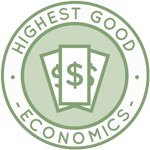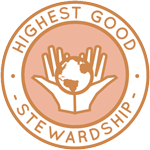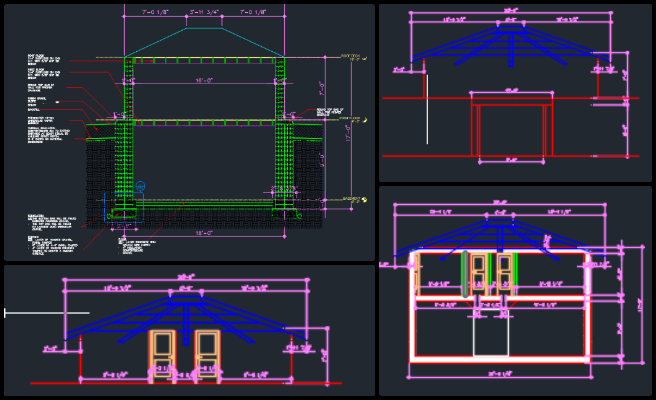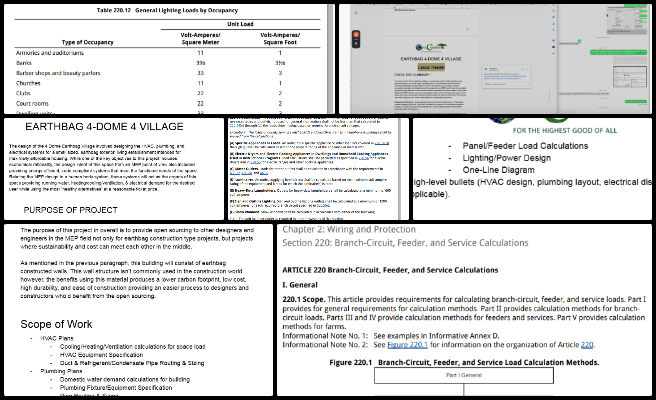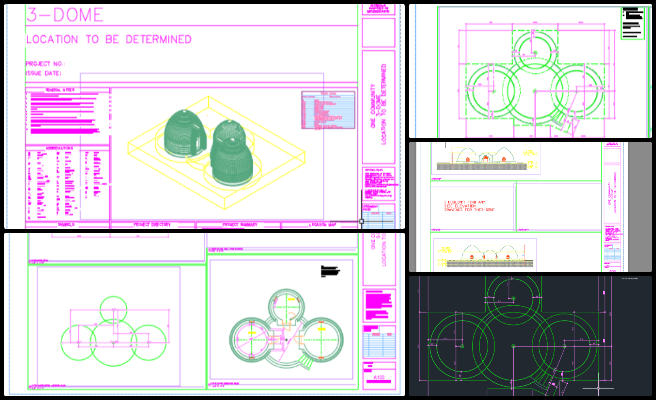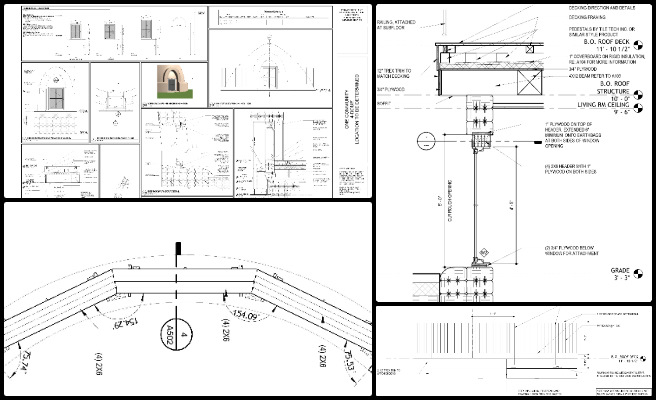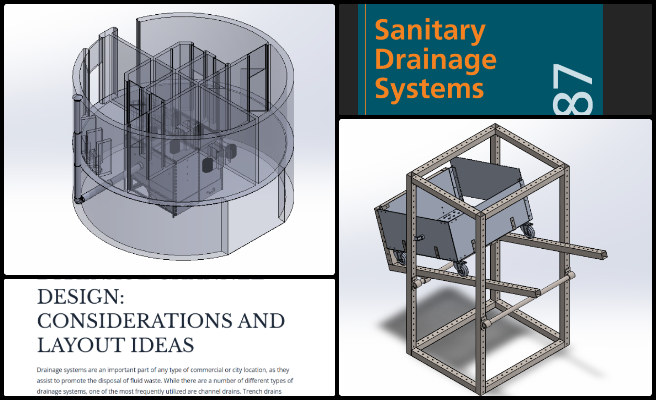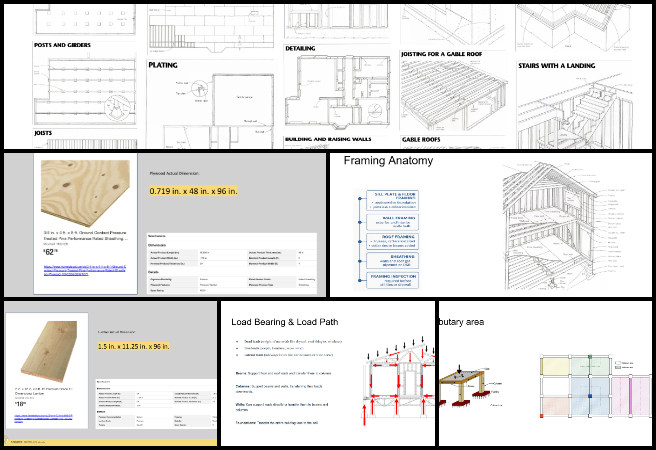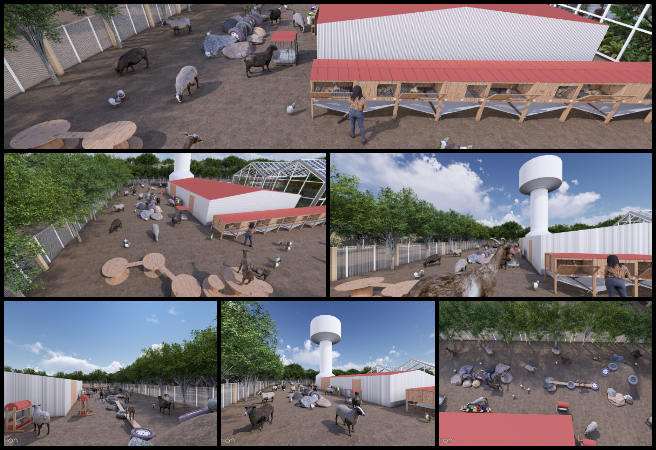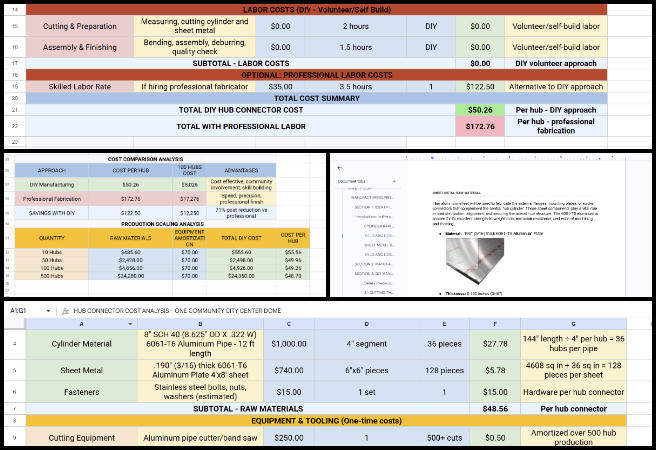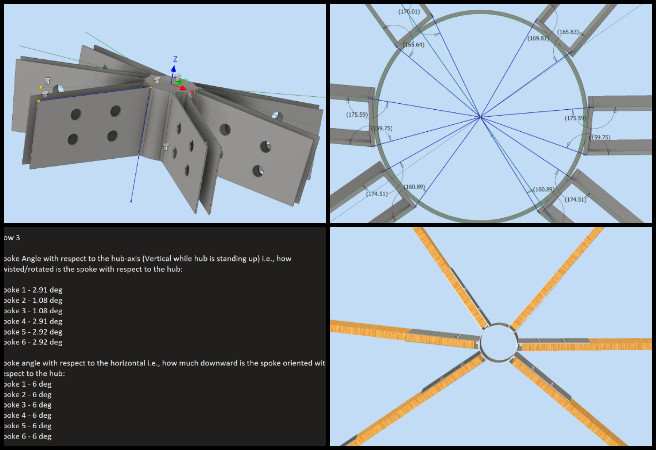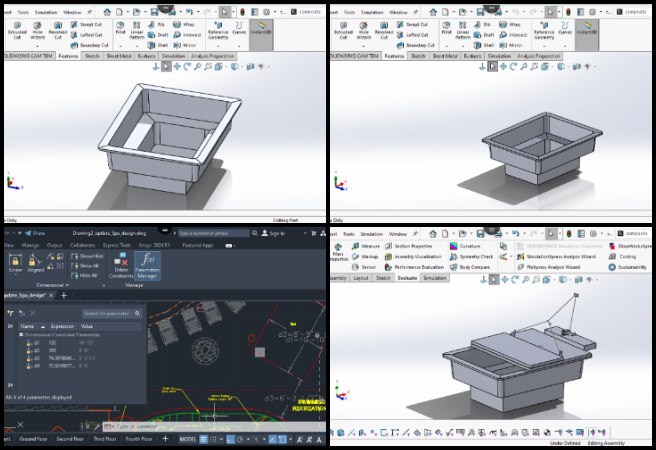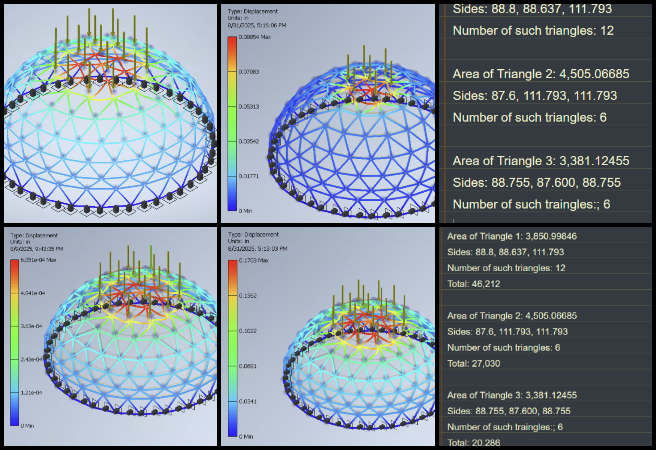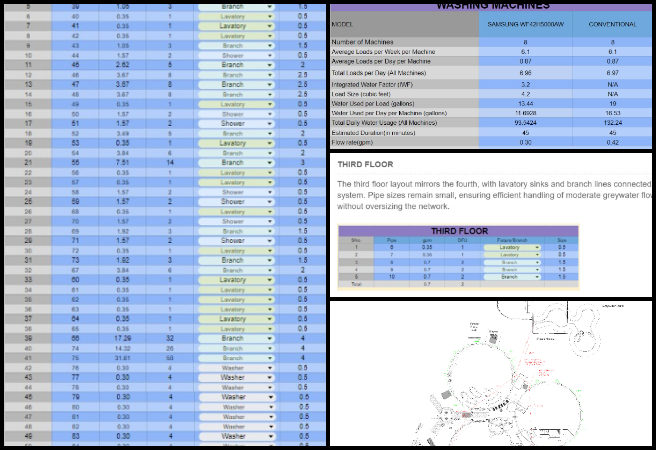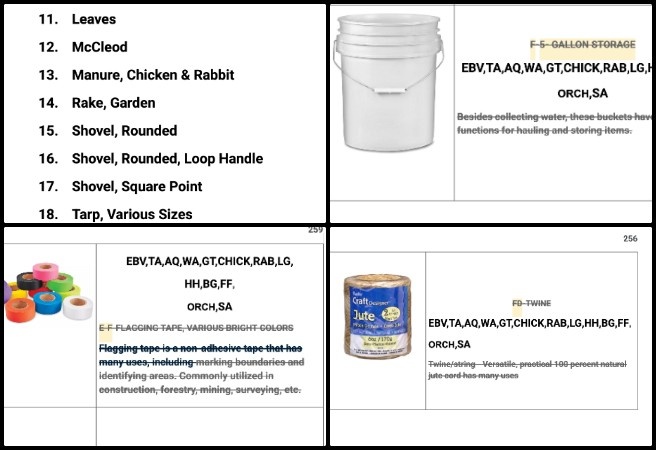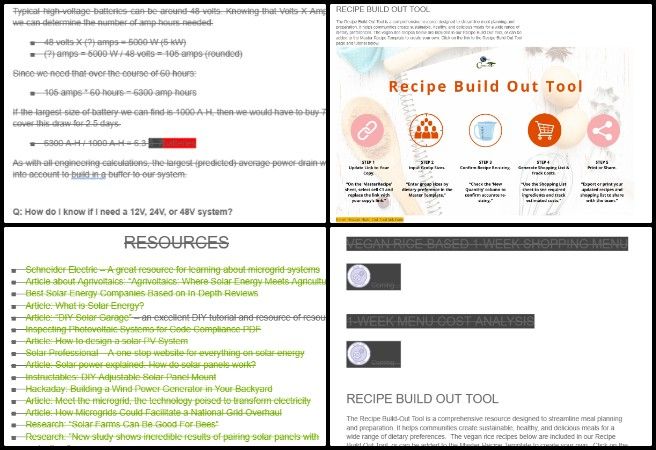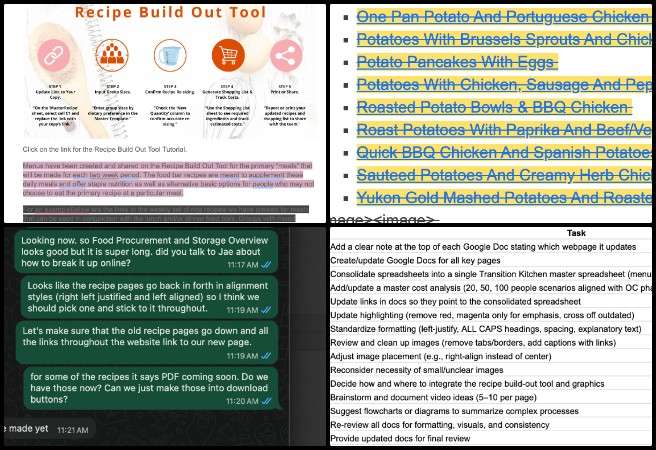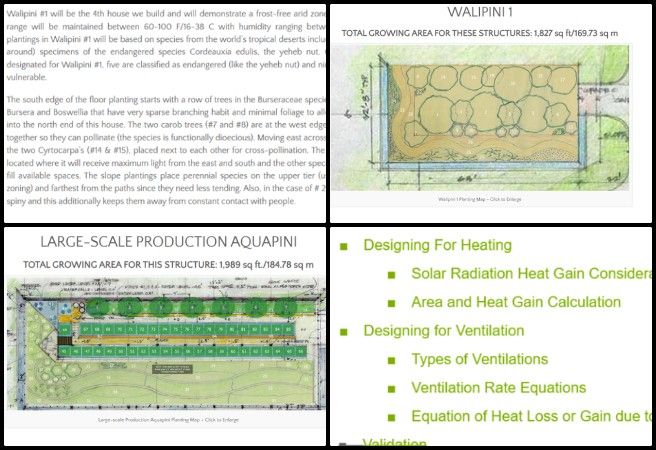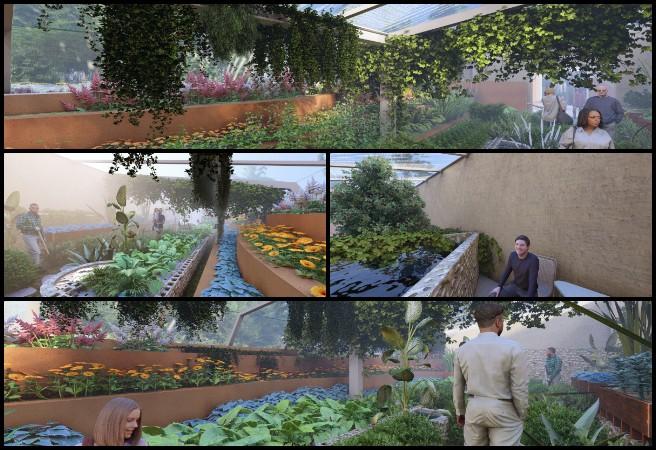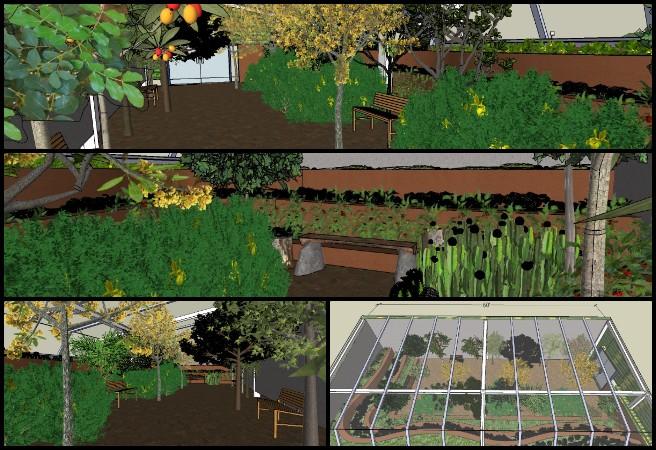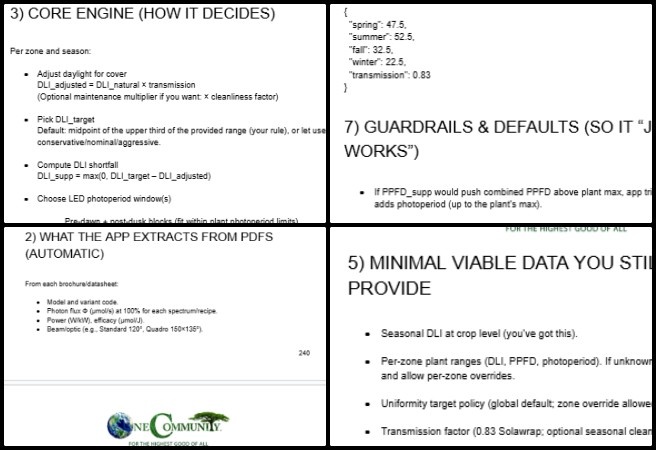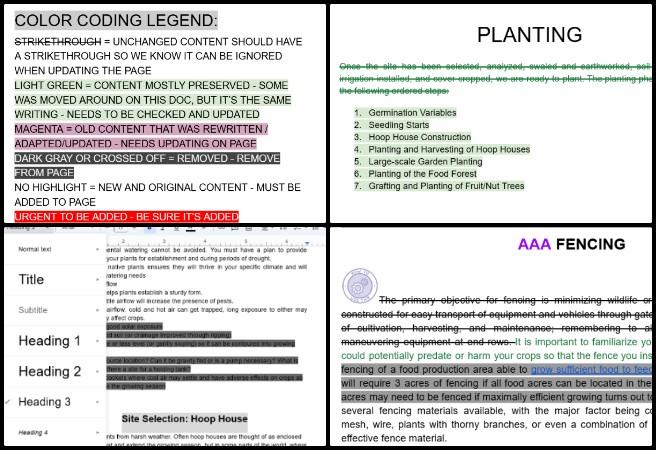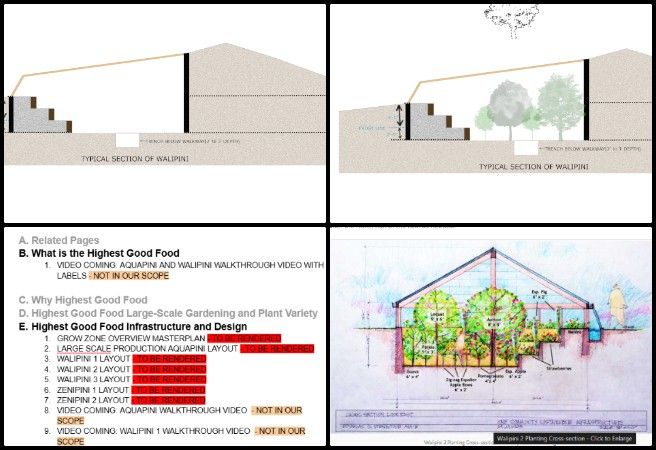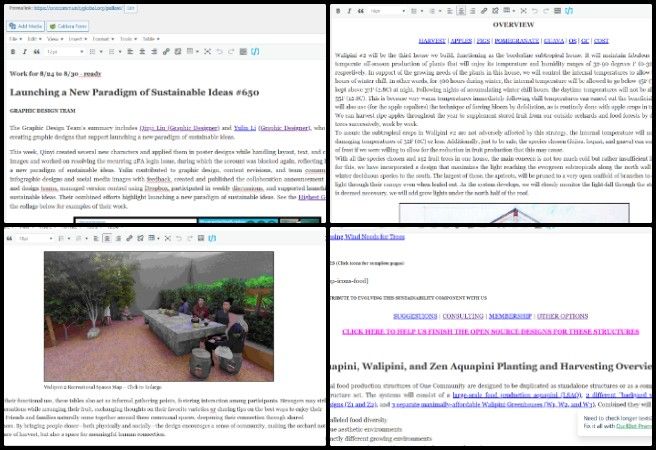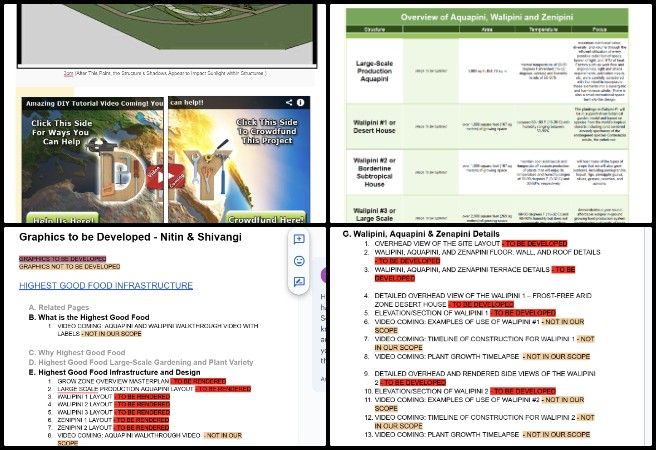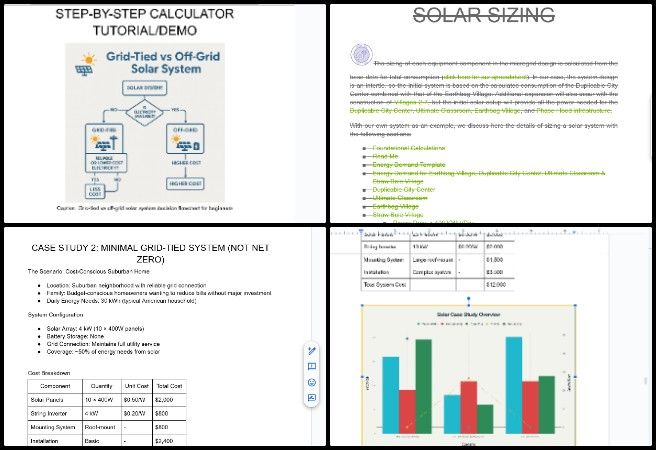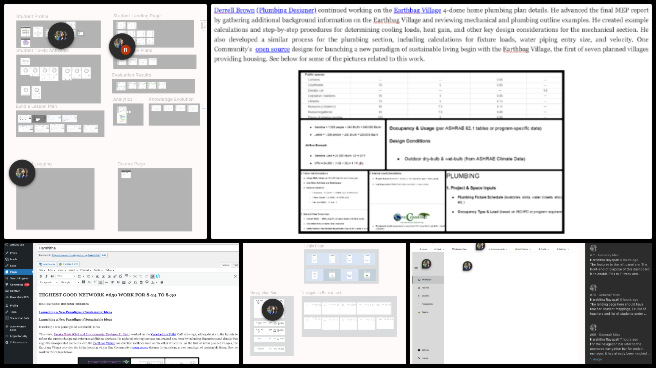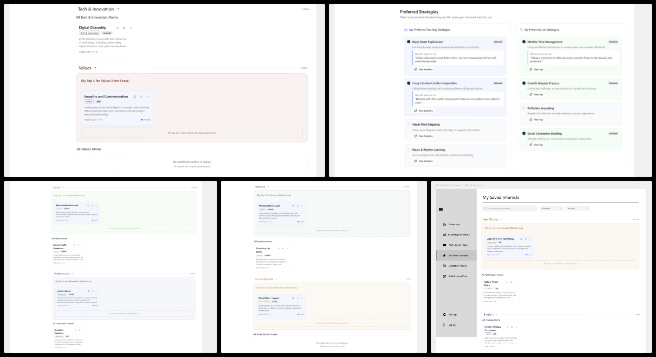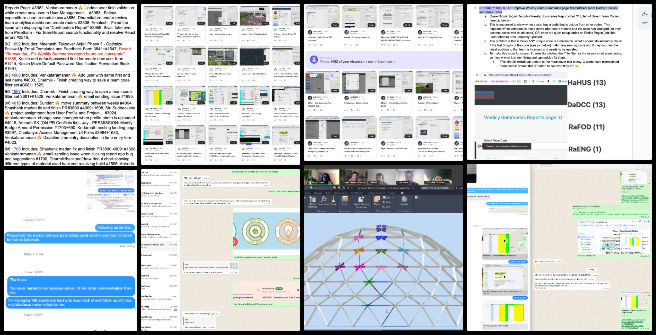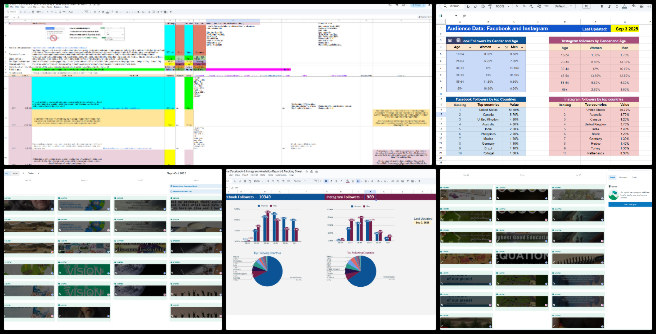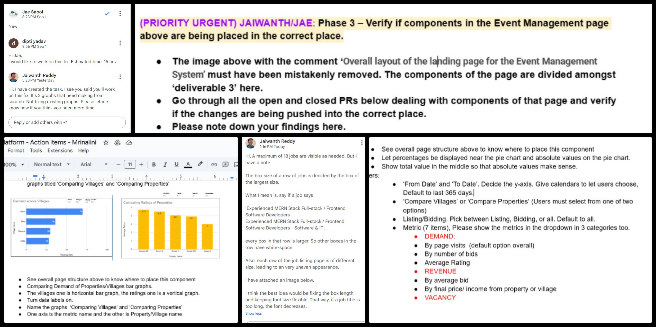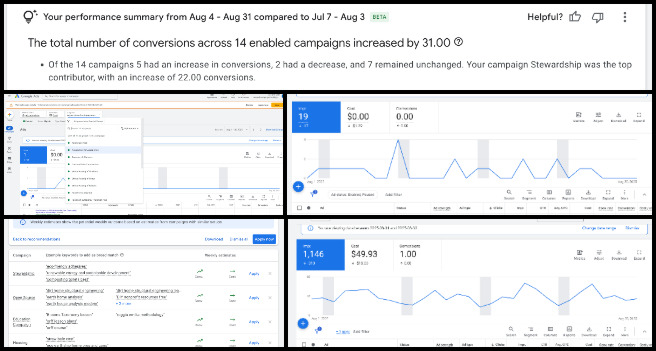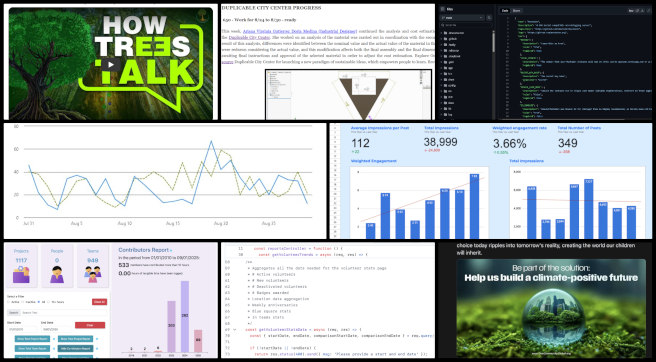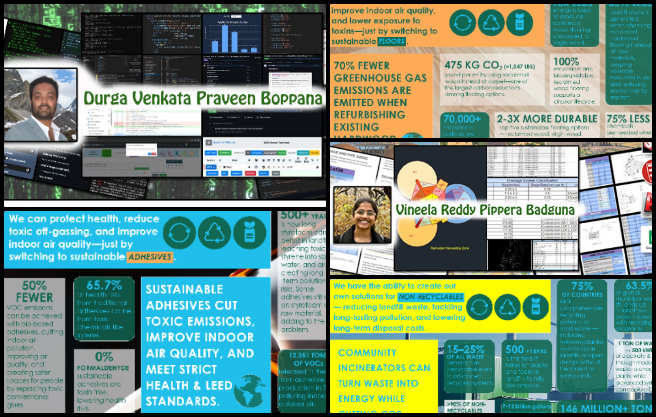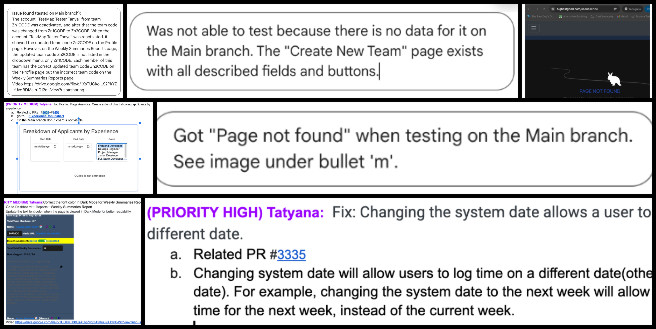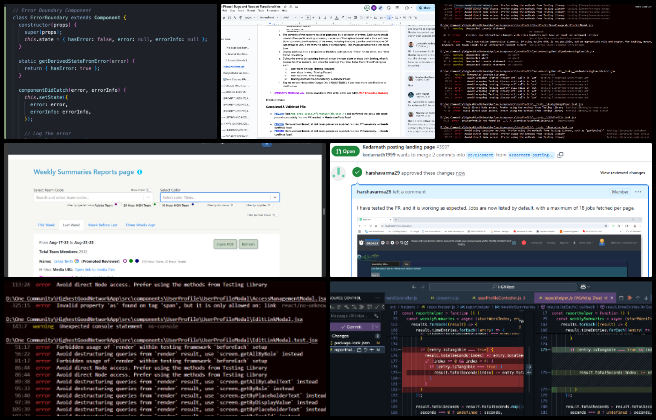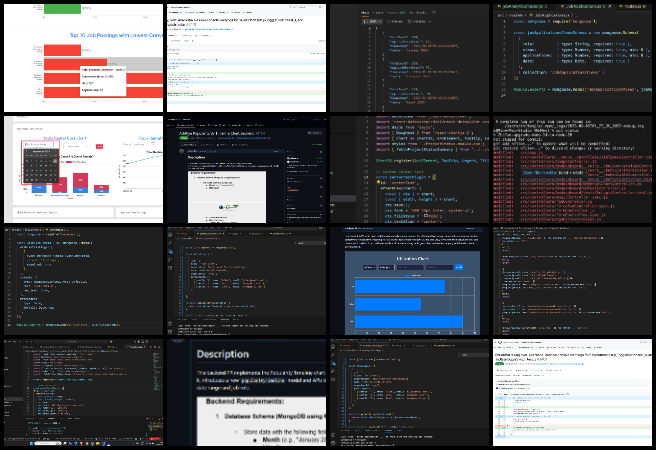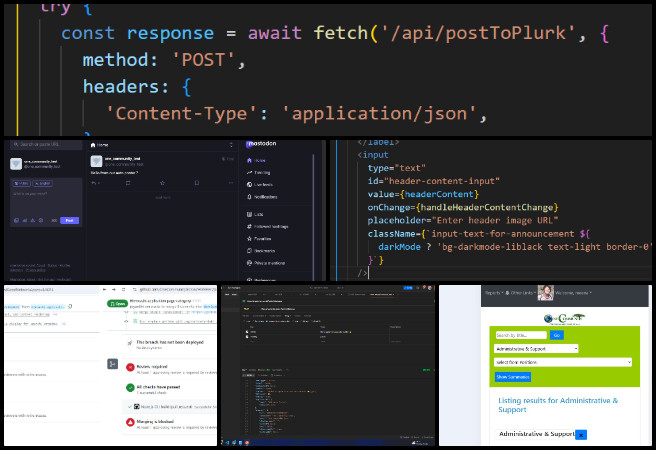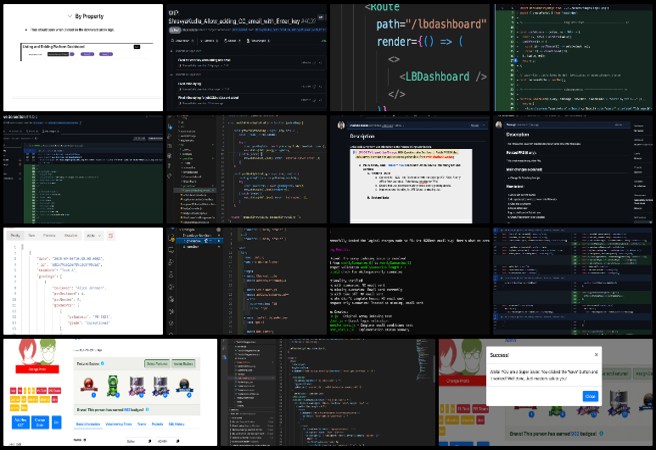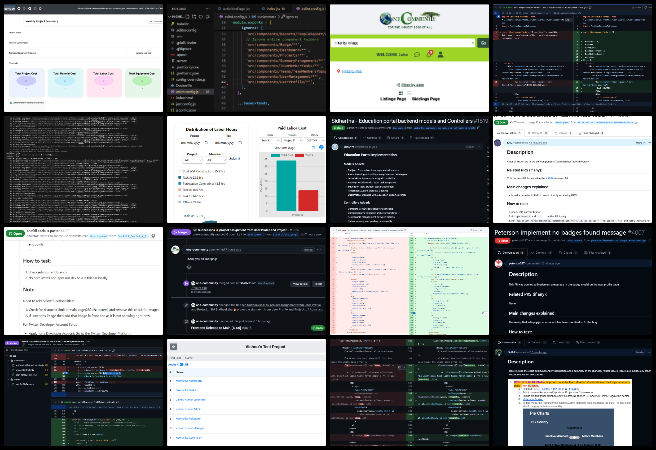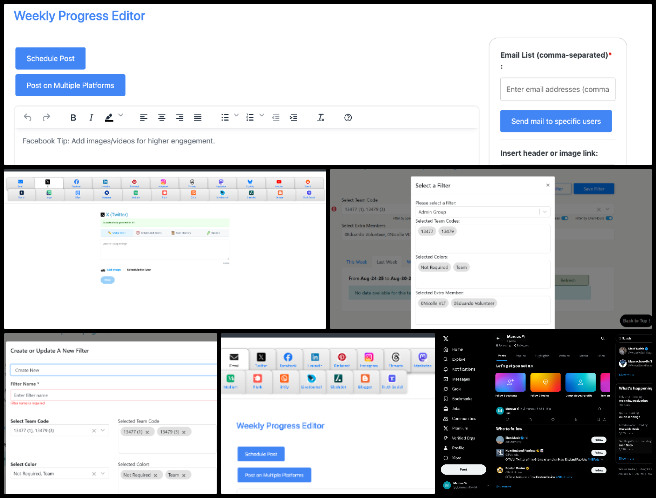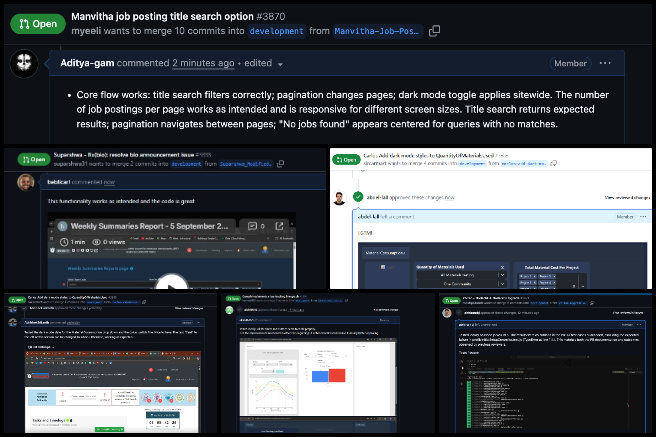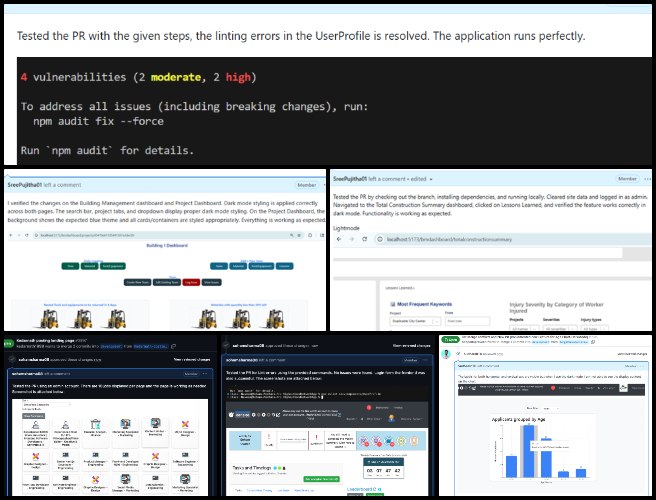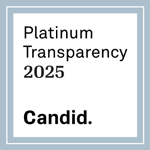Open Source Utopia Models – One Community Weekly Progress Update #651
We at One Community are creating open source utopia models designed to demonstrate how sustainable approaches to food, energy, housing, education, economics, social architecture, and fulfilled living can come together as a blueprint for global stewardship practices. Built by an all-volunteer team and open sourcing and free sharing the complete process, our work is meant to evolve sustainability into a model that becomes self-replicating, supporting the creation of a global collaboration of teacher/demonstration hubs dedicated to regenerating our planet and building a world that works for everyone—always for The Highest Good of All.
- Here’s our project overview
- Here’s our world-change methodology
- Here’s how this becomes self-replicating
- Here’s how we are open source and free-sharing all the do-it-yourself designs
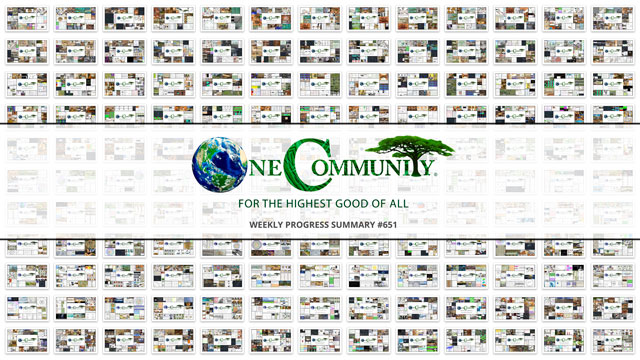
OUR MAIN OPEN SOURCE HUBS
Click on each icon to be taken to the corresponding Highest Good hub page.
One Community’s physical location will forward this movement as the first of many self-replicating teacher/demonstration communities, villages, and cities to be built around the world. This is the September 8, 2025 edition (#651) of our weekly progress update detailing our team’s development and accomplishments:
Open Source Utopia Models
One Community Progress Update #651
DONATE | COLLABORATE | HELP WITH LARGE-SCALE FUNDING
CLICK HERE IF YOU’D LIKE TO RECEIVE AN EMAIL EACH WEEK WHEN WE RELEASE A NEW UPDATE
YOU CAN ALSO JOIN US THROUGH SOCIAL MEDIA
ONE COMMUNITY WEEKLY UPDATE DETAILS
HIGHEST GOOD HOUSING PROGRESS
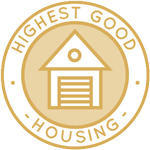 One Community is creating open source utopia models through Highest Good housing that is artistic and beautiful, more affordable, more space efficient, lasts longer, DIY buildable, and constructed with healthy and sustainable materials:
One Community is creating open source utopia models through Highest Good housing that is artistic and beautiful, more affordable, more space efficient, lasts longer, DIY buildable, and constructed with healthy and sustainable materials:
- Learn about: Our Upcoming Crowdfunding Campaign
- Learn about the different village models: 7 Sustainable Village Models
- Visit the open source portals for the first two: Earthbag Village OS Hub | Straw Bale Village OS Hub
This week, Baraka Minja (Civil and Environmental Engineer Pr. Eng.) worked on the Vermiculture Toilet and communal shower CAD drawings. He added elevation drawings to the vermiculture toilet CAD set and updated the section drawings to include additional details. For the communal shower, he focused on revising the section drawings to incorporate foundation specifications and structural elements related to earthbag construction. As the first of seven planned villages, the Earthbag Village provides the initial housing within One Community’s designs for open source utopia models. See the work in the collage below.
Derrell Brown (Plumbing Designer) continued working on the Earthbag Village 4-dome home plumbing plan details. He advanced his work on the final MEP report by gathering additional code reference information on MEP design and background information on the Earthbag Village. He reviewed the mechanical, plumbing, and electrical plans to refine the scope of work section, ensuring alignment with current design requirements. Derrell also developed step-by-step processes to identify procedures for MEP design, with a focus on the unique considerations of the Earthbag Village project. In addition, he updated the report to align with typical One Community report formatting. One Community’s designs for open source utopia models begin with the Earthbag Village, the first of seven planned villages providing housing. See below for some of the pictures related to this work.
Karthik Pillai (Mechanical Engineer) continued work on the Earthbag Village 4-dome cluster project. He focused on the roof design by completing a basic report outline, which was shared with the core team for review and feedback. In parallel, he continued work on the Vermiculture Toilet project, modifying the waste dumping mechanism to better integrate with a drawer-based system. Karthik researched design adjustments and evaluated options to improve functionality. He also updated the overall bathroom dome structure to align it with the most recent version of the Unistrut assembly. Additionally, he joined team discussions to reassess the existing design and highlight potential areas for improvement. As the first of seven planned villages, the Earthbag Village provides the initial housing within One Community’s designs for open source utopia models. See highlights of this work in the collage below.
Ketsia Kayembe (Civil Engineer) continued working on the Earthbag Village 3-Dome structure, completing the cover sheet, earthbag construction sheet, building code requirements, and elevation drawings. She shared them with Dashaarna for review and is awaiting feedback. She also worked on the floor plan drawings, completing about half of the work. In addition, Ketsia edited the plans based on last week’s feedback and the construction template, adding necessary details to bring the drawings closer to construction-ready. The Earthbag Village is the first of seven planned villages in One Community’s framework for open source utopia models, setting the stage for the housing component of this initiative. See below for some of the pictures related to this work.
Michaela Silva (Architect) continued working on details in the construction documents of the Earthbag Village. She updated the Revit models and prepared a PDF for the team. Michaela detailed the railing elevation for the rooftop deck and updated window detail sheet A502 to include two additional items. She also created a plan detail of the window header and a section detail through the dining room windows. The Earthbag Village, first of seven planned communities, represents the housing start point of One Community’s framework for open source utopia models. Her latest contributions are shown in the collage below.
Rahul Kulkarni (Mechanical Engineer) continued work on the Vermiculture Toilet. He developed conceptual ideas for the channel design and discussed them with the team along with the vermicomposting procedure. Based on team discussions, he carried out research on techniques relevant to the design. Rahul continued exploring channel design approaches while testing some initial ideas. In parallel, he implemented the newly discussed drawer design and checked its feasibility against the rest of the assembly. As the first of seven planned villages, the Earthbag Village introduces the housing element within One Community’s framework for open source utopia models. See below for visuals of this work.
Suprasanna (Architectural Designer) continued working on the 6-Dome structure by developing the sectional drawings. She focused on translating the design intent into clear section views and aligning the work with the standards outlined in the reference documents. She also incorporated remarks provided by the core team last week and began refining the drawings based on that feedback to advance the detail and accuracy of the sections. The Earthbag Village is the first of seven planned villages and establishes the housing foundation within One Community’s framework for open source utopia models. See the progress in the images below.
DUPLICABLE CITY CENTER PROGRESS
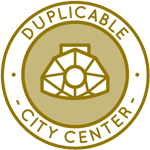 One Community is creating open source utopia models through a Duplicable and Sustainable City Center that is LEED Platinum certified/Sustainable, can feed 200 people at a time, provide laundry for over 300 people, is beautiful, spacious, and saves resources, money, and space:
One Community is creating open source utopia models through a Duplicable and Sustainable City Center that is LEED Platinum certified/Sustainable, can feed 200 people at a time, provide laundry for over 300 people, is beautiful, spacious, and saves resources, money, and space:
- Learn about this building and it’s function: Duplicable City Center Open Source Hub
This week, Andrew Tzu-Chien (Industrial Designer) continued working on the Dormer second-floor window for the Duplicable City Center. He focused his research on load-bearing methods, force distribution, structural load transfer, and tributary areas, and applied these principles to the current window design. He also collaborated with Ariana to review material options, discussed the differences between nominal and actual dimensions, and finalized the material selection for the project. The Duplicable City Center highlights One Community’s open source commitment to creating open source utopia models. The images below illustrate aspects of this work.
Anjana Reddy (Architectural Designer) completed onboarding by reviewing project files created by Jason, which were large and built in the latest version of Lumion, requiring installation of the updated software to ensure compatibility for walkaround videos of the Duplicable City Center. This work contributes to One Community’s commitment to open source utopia models. She watched the action item video to understand project requirements and began rendering the exterior of the animal section in Lumion. She incorporated feedback related to the animal farm and updated the SketchUp file, but encountered issues importing the file into Lumion that need to be resolved. Anjana worked on corrections to the renders and the walkaround video of the animal farm, completing updated renders and the final video. She was unable to update the rabbit hutch due to texture changes when importing the model from SketchUp into Lumion and the absence of original texture files for re-import. This Duplicable City Center project is creating open source utopia models through thoughtful design. For more specifics, view the image below.
Ariana Virginia Gutierrez Doria Medina (Industrial Designer) continued the analysis and cost estimation of the windows for the Duplicable City Center. She modified the dormer window assembly instructions by dividing certain components so each part could be produced from a single piece of plywood. Ariana prepared the toolpaths required for the cuts and organized them to align with the updated assembly approach. In addition, she worked on cost estimation by reviewing material requirements and calculating the necessary quantities based on the adjusted design. Explore One Community’s open source Duplicable City Center for creating open source utopia models, which empower people to learn. Browse the visuals below.
Ayushman Dutta (Mechanical Engineer) continued working on reviewing pipe materials for the Duplicable City Center hub connector design. He completed the cost analysis Excel sheet and formatted it according to manufacturing document requirements. He checked the feedback for the FEA reports from the team and worked on corrections and improvements based on their input. Ayushman also developed the manufacturing process document, researching and documenting the most suitable methods for the hub connector. He completed and formatted the report to meet project standards and requirements. This open source Duplicable City Center project is creating open source utopia models through thoughtful design. Some of this work is shown in the collage below.
Nikhil Bharadwaj (Mechanical Engineer) continued working on creating the spoke designs for the Duplicable City Center hub connector. He completed the hub and spoke design for row 3 with the 10.7-inch central hub and created 2D flattened drawings for each spoke to support fabrication and assembly. He added these drawings to the assembly spreadsheet, integrated the row 3 hub connector into the complete dome assembly, and cut the beams to create the required clearances and fit. Nikhil obtained the spoke angles with respect to the central hub and added this information to the assembly instructions. He also connected with Koushik to explain his tasks and provide an overview of the project. One Community’s Duplicable City Center is an example of creating open source utopia models. A selection of this work is shown in the visuals below.
Nupur Shah (Mechanical Engineer) continued developing Row 3 of the Duplicable City Center hub connector. She updated the project spreadsheet to capture the latest progress and made additional revisions to the beam view, adding all unique cut angles to clarify orientation and alignment. These updates created a more accurate reference for both design and future assembly work. One Community’s Duplicable City Center serves as an open source example of creating open source utopia models. Here are a few pictures that showcase this work.
Sandesh Kumawat (Mechanical Engineer) made further progress on the City Center Natural Pool and Eco-spa Designs.. He reviewed the spa area in AutoCAD to resolve interference from two existing columns, added and verified plan dimensions, and adjusted the layout so clearances between the pool and surrounding features meet the minimum ADA distance. The revised footprint was then used to update the SolidWorks 3D model, where all mates and reference geometry were redefined to reflect the new plan, plate sizes, and hardware locations. Sandesh also checked the assembly for collisions and range of motion. To prepare for validation, he began structural analysis by creating an initial preprocessing setup that included simplifying the geometry for analysis, defining material properties for the tub, plates, and fasteners, applying representative support conditions and loads, and generating a first-pass mesh for key components. These steps captured areas likely to see higher stresses such as hinge mounts and edge transitions, and the setups were saved for iteration. Discover One Community’s open source Duplicable City Center for creating open source utopia models. The following visuals illustrate highlights from this effort.
Srujan Pandya (Mechanical Engineer) continued helping with the Duplicable City Center FEA analysis. He calculated exact surface areas for multiple snow load cases and updated the snow load result sheet with the revised data. To improve efficiency and consistency, the analyses were combined into a single file for streamlined review. He also cross-checked results against prior assumptions, adjusted formatting on the result sheet, and prepared the updated file to replace the version in the Master folder on Dropbox. The Duplicable City Center demonstrates creating open source utopia models and open source design that can guide people. The images below illustrate aspects of this work.
Vineela Reddy Pippera Badguna (Mechanical Engineer) continued conducting in-depth research on greywater reuse systems for the Duplicable City Center. She included the necessary reference links in the website report based on feedback, revised the Google Sheet to improve formatting and professionalism, and corrected errors while updating calculations for the first floor. She also added new calculations and explanations to the sheet to improve clarity and understanding. In parallel, Vineela revised the report by incorporating new images and adding step-by-step descriptions that clarify how the size calculator works, along with detailed explanations for the first, second, third, and fourth floor calculations. This open source Duplicable City Center project is creating open source utopia models through thoughtful design. For more specifics, view the image below.
HIGHEST GOOD FOOD PROGRESS
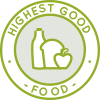 One Community is creating open source utopia models through Highest Good food that is more diverse, more nutritious, locally grown and sustainable, and part of our open source botanical garden model to support and share bio-diversity:
One Community is creating open source utopia models through Highest Good food that is more diverse, more nutritious, locally grown and sustainable, and part of our open source botanical garden model to support and share bio-diversity:
- Learn about the structures: Hoop House Hub | Aquapini & Walipini Open Source Hub
- See what we’ll be growing: Gardens & Hoop Houses | Large-scale Structures | Food Forest | TA
This week, the core team continued the final comprehensive review for the Master Tools, Equipment, and Materials/Supplies list by adding tractor attachments to various One Community projects where they were previously unlisted. This included the ongoing addition of most tractor attachments from the Orchard section to the Goat, Chickens, Rabbits, Large Garden, Botanical Garden, Earthbag Village, Soil Amendment, Food Forest, Tropical Atrium, and Apiary sections. The team also continued adding and completing an alphabetized list of tools, equipment, materials/supplies list for the Soil Amendment category. While some categories still have uncompleted tool lists, the objective is for all projects to eventually have a separate TEMS list derived from the Master Tools, Equipment, Materials/Supplies document. The Highest Good Food initiative is a key component of One Community’s open source plans, focused on open source utopia models, and exemplifies the organization’s commitment through innovative design and implementation. Below are some images showcasing this work.
The core team also completed the Highest Good Food related documents, including Food Bars, Transition Kitchen, Recipe Build-Out Tool Tutorial, Food Procurement and Storage, Food Self-Sufficiency Plan, and eight recipe pages covering vegan and omnivore versions of rice, pasta, potato, and sweet potato. The team then reviewed the Off-Grid vs Grid-Tie Analysis, made minor modifications, and added the analysis to the Solar Energy Microgrid Setup and Maintenance page. The team worked with Chelsea to create reports for Transition Kitchen, Food Bars, the Food Self-Sufficiency Plan, and all recipe pages covering rice, pasta, potato, and sweet potato for both vegan and omnivore versions. The team added references to the Recipe Build-Out Tool on each page and made changes to content and formatting to improve usability. The team also included links and video placeholders in the pages to support potential future videos. The Highest Good Food initiative plays a leading role in One Community’s open source platform by promoting sustainable and participatory development focused on open source utopia models. Below are images related to this project.
Chelsea Mariah Stellmach (Project Manager) continued her work on the Transition Food Self-sufficiency Plan menus and customization spreadsheets. She met with the core team to coordinate task assignments and determine responsibilities. Chelsea talked with the core team about finalizing the reports for resubmission, which included the vegan rice, vegan potato, vegan pasta, vegan sweet potato, omnivore rice, omnivore potato, omnivore sweet potato, omnivore pasta, food self-sufficiency plan, Recipe Build-Out Tool, Transition Kitchen, Food Nutrition Calculations, Food Bars, and Food Procurement & Storage pages. These pages, which have been worked on for several months and are now prepared for publishing, were updated by changing formatting, updating FAQs, adding a blurb, link, and graphic for the master recipe spreadsheet, and adding consultants. As an essential aspect of One Community’s open source goals, the Highest Good Food initiative supports open source utopia models as a foundation for sustainable living. Below are some images showcasing this work.
Dirgh Patel (Volunteer Mechanical Engineer) continued assisting with the Climate Battery design evolutions. He edited the final report by adding new section titles, explanations in the ventilation and heating design section, and updated the index and bookmarks to match the changes. He revised the tubing diameter consideration section and added explanations for the battery design images, then reviewed the report to verify all corrections were incorporated. Dirgh also read material on the Large-Scale Production Aquapini, Walipini 1 Frost-Free Arid Zone Desert House, and Walipini 2 Borderline Subtropical House to identify how heat and ventilation concepts could be applied or compared. Based on feedback, he clarified the heating equation and standardized the use of symbols for consistency. One Community’s open source mission is powerfully reflected in the Highest Good Food initiative, which is focused on the open source utopia models for global benefit. The following visuals illustrate highlights from this effort.
Faeq Abu Alya (Architectural Engineer) continued developing house designs for the Earthbag Village 4-dome cluster project. He worked on designs in the Southwest and Southeast areas, updating materials to reflect current project needs, integrating new features into the models, and enhancing visualizations for clearer representation of the structures. The updates were applied across both areas to ensure accuracy, consistency, and alignment with project requirements. The Earthbag Village is the first of seven planned villages to be constructed as part of One Community’s open source model for open source utopia models, and it is closely tied to the Highest Good Food initiative. Below are some pictures related to this work.
Gayatri Pandkar (Architect) continued contributing to the Highest Good Food. She adjusted the plantation tree layout to align with the initial plan, researched the Desert Botanical Garden for planting strategies and references, explored seating options suitable for the site, and incorporated new ground-level planting elements. She also reviewed how these changes fit within the overall layout to maintain design consistency and support the intended functionality of the space. The Highest Good Food initiative plays a leading role in One Community’s open source platform by promoting sustainable and participatory development focused on open source utopia models. Below are visuals highlighting this work.
Jay Nair (BIM Designer) continued working on Aquapini and Walipini Planting and Harvesting. He worked on editing the document to standardize its format according to the webpage requirements while also developing the specifications for an online lighting energy calculator. His tasks included adjusting the structure and layout of the document for consistency and outlining the inputs, calculations, and outputs needed for the tool. The Highest Good Food initiative plays a leading role in One Community’s open source platform, promoting and supporting the open source utopia models through sustainable and participatory development. See below for pictures related to this work.
Keerthi Reddy Gavinolla (Software Developer) continued working on the Highest Good Food page. She reviewed the admin work of Yagna and Keerthana. She continued working on the Soil Amendment and Initial Off-grid Site Preparation page, sent the updated document for review to Jae, and made the necessary changes as per Jae’s suggestions. Keerthi also completed her admin work for the week. Built on One Community’s open source foundation, the Highest Good Food initiative is dedicated to open source utopia models, empowering communities through self-sustaining systems. View examples of her work in the pictures below.
Nitin Parate (Architect) continued contributing to the Highest Good Food. The work focused on Walipini 2, for which a cross section was required. Time was spent researching and reviewing available information on the design and layout of Walipini structures, with specific attention to planting patterns inside, including their arrangement by height and spacing. Based on this research, a draft cross section was prepared to represent both structural and planting aspects accurately. The work continued with rendering the cross section in GIMP, where color, textures, and shading were applied to highlight structural elements, soil layers, and planting zones. Plant details were also added to improve clarity and distinguish between different elements. In addition, the tasks assigned for Highest Good Food on the open source page provided by Shivangi were reviewed to understand the scope and requirements for further contribution. The Highest Good Food initiative plays a leading role in One Community’s open source platform, promoting and supporting the open source utopia models through sustainable and participatory development. Below are some images showcasing this work.
Pallavi Deshmukh (Software Engineer) continued working on the Aquapini and Walipini Planting and Harvesting page. Pallavi completed and submitted information for one interview and scheduled more for next week. She created new content for blog 650, and worked with teammates by reviewing their suggestions and incorporating feedback to produce a clear and consistent final version. She applied Jae’s feedback and finished adding Zenapini #2 content from Silin to the website, then moved on to Walipini #2, where she incorporated Junyi Shi’s work with updated text, links, and images for the webpage. In alignment with One Community’s open source objectives, the Highest Good Food project integrates the concept of open source utopia models into a larger vision of regenerative living. Her contributions are highlighted in the collage below.
Shivangi Varma (Volunteer Architectural Designer And Planner) continued contributing to the Highest Good Food. She completed edits for the Open Source Hub page based on feedback, continued coordinating with the volunteer architect on graphics, and worked on editing content for the Planting and Harvesting page. The Highest Good Food initiative plays a leading role in One Community’s open source platform by promoting sustainable and participatory development focused on open source utopia models. Below are visuals highlighting this work.
HIGHEST GOOD ENERGY PROGRESS
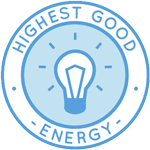 One Community is creating open source utopia models through Highest Good energy that is more sustainable, resilient, supports self-sufficiency and includes solar, wind, hydro and more:
One Community is creating open source utopia models through Highest Good energy that is more sustainable, resilient, supports self-sufficiency and includes solar, wind, hydro and more:
- Learn about the open source sustainable-energy foundations: Solar, Hydro, and Wind
- Explore our research into the most sustainable products and companies for saving water and energy: Insulation, Eco-laundry, Lightbulbs and Light Bulb Companies, Doors and Door Companies, Windows and Window Companies, Toilets, Faucets and Faucet Accessories, Urinals, and more.
This week, Shravan Murlidharan (Volunteer Electrical Engineer) continued supporting with the Highest Good Energy. He focused on editing the One Community Energy webpage, including color-coding information, adding new contributions, and proofreading content for clarity and consistency. Shravan reviewed sections of the webpage to ensure highlighted information aligned with intended categories, while refining the structure to integrate both original and added material clearly. He also addressed core team comments, making adjustments to incorporate their feedback. Across multiple editing sessions, the content was polished to improve readability and maintain alignment with project standards. One Community’s open source mission is powerfully reflected in the Highest Good Energy initiative, which helps in open source utopia models as a model for global benefit. Below are some of the images showcasing this work.
HIGHEST GOOD EDUCATION PROGRESS
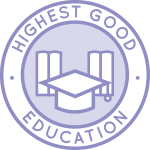 One Community is creating open source utopia models through Highest Good education that is for all ages, applicable in any environment, adaptable to individual needs, far exceeds traditional education standards, and more fun for both the teachers and the students. This component of One Community is about 95% complete with only the Open Source School Licensing and Ultimate Classroom construction and assembly details remaining to be finished. With over 8 years of work invested in the process, the sections below are all complete until we move onto the property and continue the development and open sourcing process with teachers and students – a development process that is built directly into the structure of the education program and everything else we’re creating too:
One Community is creating open source utopia models through Highest Good education that is for all ages, applicable in any environment, adaptable to individual needs, far exceeds traditional education standards, and more fun for both the teachers and the students. This component of One Community is about 95% complete with only the Open Source School Licensing and Ultimate Classroom construction and assembly details remaining to be finished. With over 8 years of work invested in the process, the sections below are all complete until we move onto the property and continue the development and open sourcing process with teachers and students – a development process that is built directly into the structure of the education program and everything else we’re creating too:
- Program Overview: Education Open Source Hub
- How the components work together in designing human orchestrated eco-abundance: How to use the Education for Life Program
- Lesson Plans for Life – Lesson Plans How-to
- Foundations of Outstanding Leaders, Teachers, and Communicators
- Curriculum for Life
- Teaching Strategies for Life
- Learning Tools and Toys for Life
- Evaluation and Evolution
This week, Anuneet Kaur (Administrator) continued contributing to the Highest Good Education software platform by creating Figma design elements and refining the overall visual layout, supporting One Community’s dedication to highest good future building. She focused on researching resources for the most sustainable urinals and non-recyclables, reviewing scholarly articles, and compiling relevant statistics for the graphic process. Anuneet ensured all members were included in the live blog task and identified anyone who was missing. She also completed drafting the content and selecting images for the Highest Good Education Program Licensing and Accreditation webpage. In addition, she reviewed Yulin’s sustainability infographic and provided feedback to improve its clarity and impact. Her administrative contributions included editing summaries and collages for the Highest Good Society team, Highest Good Education, and core team, while reviewing fellow admins’ submissions for accuracy and completeness. The One Community model of open source utopia models, exemplified by sustainably built classrooms like these, fosters lasting impact on a global scale. Her recent contributions are featured in the collage below.
Harshitha Rayapati (Program Manager) continued advancing the Highest Good Education continued advancing the Highest Good Education platform by detailing deliverables, developing Figma designs, and expanding the visual layout of the student dashboard. She focused on breaking down action items into PRs for the Educator side to ensure consistency across all software components. Harshitha reviewed feedback from Raahul and Srushti and incorporated it into the deliverables breakdown, adding context and details where needed. She assigned Figma design tasks to Srushti based on the prioritized Figma designs list and the remaining front-end PRs for Deliverables 1, 2, and 3 that still required screenshots. She also provided input on the Project Manager Dashboard designed by Anuneet and added comments on Ravi’s Figma designs for the student dashboard and other general design elements. In addition to this, Harshitha worked on compiling the weekly blog update, reviewed the Housing team’s progress, edited the blog page, and created a collage. The One Community model of open source utopia models, exemplified by sustainably built classrooms like these, drives meaningful global change. The collage below highlights her recent contributions.
Ravi Kumar Sripathi (Software Engineer) continued developing the Highest Good Education continued developing the Highest Good Education software platform by creating Figma designs and refining the Build Lesson Plan module, which enables students to transform their saved interests into weekly learning plans through guided steps. He designed wireframes to support personalization and prioritization features within the platform. Ravi also created an atom display with shortlisting functionality, allowing students to view saved atoms with titles, descriptions, and interactive options such as shortlisting, viewing details, or removal. In addition, he developed the “My Top 3 for [Subject]” section, enabling students to identify their next focus areas with distinct visuals, reordering options, and removal actions. He further added dedicated sections for managing preferred strategies, including teaching and life strategies, with scrollable lists, selection toggles, and links for accessing additional tips. These updates strengthened both the functionality and user experience of the platform, enhancing the One Community model of open source utopia models as a path to lasting global impact. Below are images related to his work.
HIGHEST GOOD SOCIETY PROGRESS
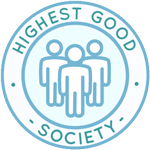 One Community is creating open source utopia models through a Highest Good society approach to living that is founded on fulfilled living, the study of meeting human needs, Community, and making a difference in the world:
One Community is creating open source utopia models through a Highest Good society approach to living that is founded on fulfilled living, the study of meeting human needs, Community, and making a difference in the world:
- Read the Highest Good society overview: Highest Good Society
- Learn about the model for fulfilled living and sharing: A Day in the Life
- Learn about the 4 economic models: RBE | For-profit | Non-profit | Entrepreneurship
- Learn about our open source community collaboration and management software: The Highest Good Network
This week, the core team completed over 46 hours managing volunteer work reviews, handling emails, overseeing social media accounts, supporting web development, identifying new bugs, integrating bug fixes for the Highest Good Network software, and interviewing and onboarding new volunteer team members. They also produced and integrated the video above, highlighting how open source utopia models serve as the foundation of One Community’s broader mission. The following images showcase highlights of this work.
Govind Sajithkumar (Project Manager) continued focusing on analytics and content management for Meta’s Facebook and Instagram channels. He created and scheduled posts for posts for both platforms, entering details such as category, text, and post type into the shared spreadsheet. He also updated the social media analytics spreadsheet with the latest performance metrics, audience demographics, and engagement statistics. In addition, Govind managed PR reviews by updating the WordPress site with the team’s weekly summary and collage, filling the PR Review Team Table, and updating the Highest Good Network PR spreadsheet. He submitted his admin feedback table, further supporting One Community’s mission of open source utopia models. The images below highlight key aspects of his contributions.
Jaiwanth Reddy Adavalli (Project Manager) continued developing the Job Applicants page and key components of the Highest Good Network Phase 2 and Phase 4 dashboards, including the PR Team analytics section. He worked on the Listing and Bidding Dashboard by editing graph action items and tracked updates in software management documents to support task coordination. Jaiwanth also tested multiple pull requests in the Highest Good Network software. As a member of the pull request review team, he reviewed submissions from the volunteers assigned to him. This work supports One Community’s commitment to open source utopia models. The images below highlight his contributions.
Rajrajeshwari Gangadhar Sangolli (Data Analyst) continued working on Google Ads management and strategy evolution. She improved account performance by adjusting keywords, ad groups, and campaigns, expanding reach with broad match keywords while removing 81 non-serving ones. New ad groups were created to highlight transition kitchens within the food campaign, Highest Good Energy, philosophy, and Highest Good Education, as well as additions to the highest philosophy model covering purpose, vision, mission, and solution. This effort supports One Community’s dedication to open source utopia models. She also updated headlines, descriptions, and images to strengthen ad relevance and analyzed food and energy ad groups to improve performance. Rajrajeshwari further updated reporting processes with a weekly reporting sheet, tracked KPIs, and prepared monthly performance metrics while documenting data-driven recommendations. Google’s automated suggestions were applied selectively to optimize conversions while maintaining ROI. This project supports One Community’s commitment to open source utopia models. The images below highlight key aspects of her work.
ADMINISTRATION TEAM
The Administration Team’s summary, which covers their work on the Highest Good Network, was managed by Prudhvi Marpina (Machine Learning Engineer) and includes Ashutosh Mishra (Software Engineer), Dashaarna Srinivasa (Project Engineer), Divanshu Bakshi (Team Admin), Georgina George (Business Intelligence Analyst), Keerthana Chitturi (System Administrator), Neeharika Kamireddy (Data Analyst), Olawunmi “Ola” Ijisesan (Administrative and Management Support), Olimpia Borgohain (Data Analyst and Team Administrator), Rachna Malav (Data Analyst), Rishi Sundara (Quality Control Engineer and Team Administrator), Rishitha Adepu (Administrator), Sai Suraj Matta Veera Venkata (Business Data Analyst), Samhitha Are (Administrator), and Yagna Reddy Badvel (Data Analyst and Team Administrator).The Administration Team supports the Highest Good Network, a tool designed to manage and objectively measure progress while building open-source solutions for global sustainability. Through administrative support, documentation, testing, training, recruiting, analytics, and content management, the team contributes directly to creating open source utopia models and One Community’s mission of building a replicable framework for a sustainable world.
This week, Ashutosh focused on custom embedding storage and endpoint data retrieval, creating a Colab proof of concept for embeddings without a vector database, integrating cosine similarity indexing, and handling timelog admin for 170+ users while also compiling Dev Dynasty team reports. Dashaarna supported Blog #650 by preparing summaries and collages, interviewing team members, verifying construction drawings, and participating in team discussions. Divanshu advanced Mastodon analytics by testing APIs, creating mock datasets, building Power BI visualizations for engagement trends, planning strategies, assigning developer tasks, and reviewing PR implementations. Georgina created and shared over 25 content pieces, cross-posted them on Reddit, and reviewed teammate work with constructive feedback. Keerthana managed multiple responsibilities including blog creation, admin feedback changes, PDF uploads, manager ratings, summaries, and Phase 3 configuration testing against Figma designs with documented test data. Neeharika reviewed software management docs and PR dashboard items, followed up with task owners, tested PRs, handled admin duties, and conducted five interviews.
Ola organized HGN data by monitoring, reviewing, and preparing files and folders to ensure accuracy and readiness for administrative use. Olimpia supported new admin trainees, monitored volunteer task completion, resolved past comments, flagged potential issues, and analyzed LinkedIn KPIs. Rachna focused on SEO work, website exploration, and interview scheduling, though progress was limited by admin availability. Rishi merged individual blogs into Blog #650, completed SEO, reviewed and tested PRs, flagged high-priority ones, and tracked merge-ready PRs for Jae. Rishitha updated bios, requested missing details, interviewed six people, scheduled additional interviews, posted on Threads, and monitored pending workflows. Sai Suraj advanced LinkedIn Dashboard integration by fixing broken connections, validating visuals, standardizing filters, finalizing calculated column logic, and compiling admin reports with SEO edits and image organization. Samhitha completed the weekly admin blog, conducted Phase 3 testing, tracked PR statuses, tested user roles, and documented issues with feedback. Yagna updated the Expressers blog, tested dashboards as a Level 1 Tester, reviewed backend logic, and verified numbers by comparing Leaderboard and Org Summary dashboards. To learn more about how this work contributes to creating open source utopia models, visit the Highest Good Society and Highest Good Network pages. Highlights of the team’s contributions are shared in the collage below.
GRAPHIC DESIGN TEAM
The Graphic Design Team’s summary includes Qinyi Liu (Graphic Designer) and Yulin Li (Graphic Designer), who focused this week on creating graphic designs that support open source utopia models. Qinyi created bio images, announcements, and website pages for assigned people, worked on updates from the previous week, and resolved a WordPress login issue where the 2FA code was showing as invalid. After discussing with Jae, she identified the source of the issue, implemented a solution, and updated related content to align with open source utopia models. Yulin contributed by revising infographics and announcements, posting the Highest Good Network collaboration update, managing assets in Dropbox, participating in review discussions, and updating project materials. Together, their efforts support and advance open source utopia models. See the Highest Good Society pages and the collage below for examples of their work.
HIGHEST GOOD NETWORK PROGRESS
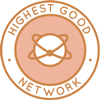 One Community is creating open source utopia models through open source Highest Good Network® software that is a web-based application for collaboration, time tracking, and objective data collection. The purpose of the Highest Good Network is to provide software for internal operations and external cooperation. It is being designed for global use in support of the different countries and communities replicating the One Community sustainable village models and related components.
One Community is creating open source utopia models through open source Highest Good Network® software that is a web-based application for collaboration, time tracking, and objective data collection. The purpose of the Highest Good Network is to provide software for internal operations and external cooperation. It is being designed for global use in support of the different countries and communities replicating the One Community sustainable village models and related components.
- Learn about our open source community collaboration and management software: The Highest Good Network
This week, the core team continued working on the Highest Good Network software by completing and confirming several pull request fixes. Confirmed fixes included adding the number of blue squares to the User Management Page (PR #3550+1410), improving task efficiency in WBS (PR #3634), implementing date range comparison filters (PR #3408), correcting email notifications for last-day settings (PR #3547), and applying hotfixes (PR #3650). These contributions reflect One Community’s dedication to open source utopia models.
Unresolved items included creating separate subscribe/unsubscribe pages (PR #3566+1418), addressing the team code outlier notification with red “!” (PR #3570+1424), and fixing the date-change loophole that allows incorrect time logs (PR #3335). Additional work involved reviewing assigned badges for “Tester One” and logging 4 hours for the week while noting repeated issues with the “New Max” badge, testing PR #3064 “Phase 2: Create New Team (/bmdashboard/AddNewTeam)” where no data was available on the main branch, verifying trophy assignments with PR #3280+1273, and assigning tasks to three volunteers. The team also reported new bugs, including font color corrections in Dark Mode for Weekly Summaries Reports, creating a donut chart for Job Posting Page Analytics showing applicants by experience, and preventing system date changes from altering logged hours. See the Highest Good Society and Highest Good Network pages for more on how this work strengthens open source utopia models.
ALPHA SOFTWARE DEVELOPMENT TEAM
This week, the Alpha Software Team, working on the Highest Good Network software, was managed by Carlos Martinez (Full-Stack Software Developer) and Nikita Kolla (Full Stack Developer). This platform supports internal management and communication in service of open source utopia models. Carlos focused on migrating the HGN Form and User Skills page to module CSS, confirmed prior migration work, reformatted the User Skills page into a two-column layout, and prepared both pages for dark mode implementation to improve skill-sharing. Nikita resolved merge conflicts for the task ensuring core team members’ additional hours processed correctly, replaced an alert with Toastify to fix a bug, addressed dark mode display issues, and finalized styling and code updates for consistency across the interface. To learn more about how this work supports open source utopia models, visit the Highest Good Society and Highest Good Network pages, and see the collage below for examples.
BINARY BRIGADE SOFTWARE DEVELOPMENT TEAM
The Binary Brigade Team’s summary, presenting their work on the Highest Good Network software, was managed by Nikhil Routh (Software Engineer) and included Amalesh Arivanan (Software Engineer), Ramsundar Konety Govindarajan (Software Engineer), Harsha Rudhraraju (Software Engineer), Sourabh Bagde (Software Developer), Srushti Patel (Software Developer), Kanishk Agarwal (Software Engineer), Rishitha Chirumamilla (Software Engineer), Manvi Kishore (Software Engineer), Taariq Mansurie (Full-Stack Developer), and Vishnu Kumar (Software Engineer). The Highest Good Network software is our tool for managing and objectively measuring progress, ensuring that all contributions are tracked, aligned with our mission, and open source utopia models.
This week, Amalesh resolved linting errors in the UserProfile folders, fixed display issues in the Contributors Report, and corrected the Projects/People/Teams page on narrow screens. Harsha reviewed multiple frontend and backend PRs, resolved whitespace and access issues, confirmed fixes, and tracked CSS-to-module-CSS updates. Kanishk fixed the white screen bug caused by multiple tabs, implemented error handling, and applied an urgent hotfix for setup email failures. Manvi added Pinterest auto-posting support with new routing, controller, and scheduling modules. Ram identified and reverted PR #1678, investigated resulting bugs in weekly summaries, and traced redundant logic back to PR #1573.
Rohit mapped the badge validation workflow, analyzed dependencies, and began drafting proof-of-concept scripts for automation. Sourabh reviewed the Phase I Bugs and Features document, claimed new features, and improved code quality. Srushti identified an urgent bug in the HGN app, updated the Teacher Portal Figma page, and completed cleanup tasks. Taariq improved weekly summaries and user tracking by fixing counts, verifying cronjob triggers, and publishing media updates. Vishnu resolved user search issues in the projects dashboard, updated query handling, tested add/remove operations, and submitted frontend and backend pull requests. Highest Good Society and Highest Good Network pages for more about how this relates to open source utopia models. The collage below shows images of their work.
BLUE STEEL SOFTWARE DEVELOPMENT TEAM
This week, the Blue Steel Software Team, working on the Highest Good Network software, was managed by Divanshu Bakshi (Product Manager) and includes Linh Huynh (Software Engineer), Humemah Khalid (Software Engineer/Backend Developer), and Sheetal Mangate (Software Engineer).
Humemah worked on the bell notification feature for task deadlines, triggering alerts at 50%, 75%, and 90% of a task’s duration, building on existing deadline tracking logic and supporting One Community’s dedication to open source utopia models. Linh investigated the FAQ logging issue in the HighestGoodNetwork app, traced API calls, identified frontend/backend misconfigurations, proposed backend updates for proper logging, and prepared frontend updates and unit tests for multiple scenarios. Sheetal resolved issues after upgrading to Node.js v20, addressed merge conflicts in the announcement code, and merged updates into the latest branch. During testing, she encountered failing cases that blocked commits and temporarily shifted focus back to development tasks while continuing to investigate test failures. These contributions highlight the team’s ongoing work toward One Community’s commitment to open source utopia models. See the pictures related to their work below.
CODE CRAFTERS SOFTWARE DEVELOPMENT TEAM
The Code Crafters Team, covering their work on the Highest Good Network software, was managed by Sai Shekhar Reddy Moola (Software Engineer) and includes Ajay Naidu (Software Engineer), Ashrita Cherlapally (Software Engineer), Benitha Sri Panchagiri (Software Engineer), Chaitanya Swaroop Kumar Allu (Software Engineer), Humera Naaz (MERN Developer), Juhitha Reddy Penumalli (Software Engineer), Rohith Mallipudi (Software Engineer), and Sphurthy Satish (Software Engineer). The Highest Good Network software is how we’ll manage and objectively measure our process for establishing abundant community systems through our social architecture, construction, production, and maintenance processes, and support widespread and lasting eco-lifestyle access. This effort exemplifies One Community’s open source commitment to open source utopia models as a path to global sustainability.
This week, Ajay added a feedback route in the application router, implemented permission checks for authenticated users, and built a landing page and modal for the feedback UI, including a five-star rating system with optional comments. Ashrita resolved merge conflicts across multiple PRs, fixed ESLint and Jest issues, standardized Yarn dependencies, and verified builds to stabilize the testing environment. Benitha corrected compile errors, updated reducers and imports, and ensured successful builds after changes, requesting additional hours for unresolved issues. Chaitanya finalized the Access Management system, updated environment variables, and documented deployed versions for future reference. Humera reviewed a large PR with multiple merge conflicts, identified misconfigured backend routes, and documented impacted endpoints. Juhitha enhanced the Phase 2 Summary Dashboard line chart, fixed date-range issues, integrated dark mode, and tested API and mock data.
Rohith reviewed multiple pull requests, coordinated on a major design and cleanup task, and continued active team communication. Sai began work on the Phase 2 Summary Dashboard horizontal bar graph, developing the schema, controller, and endpoint tests while addressing a GET request error. Sphurthy implemented Phase 2 dark mode updates across dashboard pages, set up student profile views, enabled teacher task assignment logic, and managed API and notification handling. These contributions strengthen One Community’s open source mission and open source utopia models. See below for pictures of the team’s work.
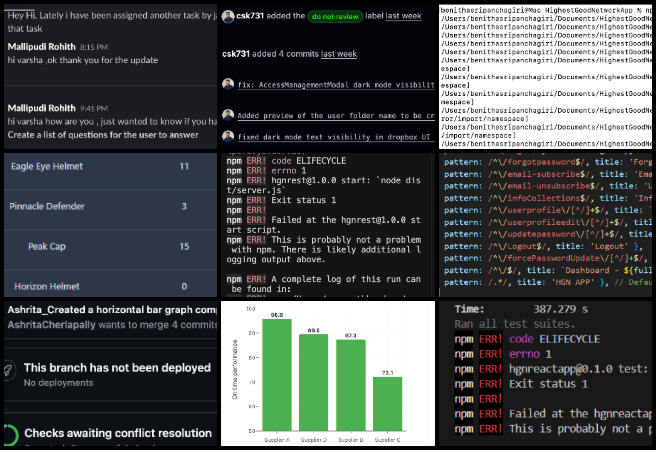
DEV DYNASTY SOFTWARE DEVELOPMENT TEAM
The Dev Dynasty Team’s summary, covering their work on the Highest Good Network software, was managed by Zhifan Jia (Software Engineer) and includes Adithya Cherukuri (Volunteer Software Engineer), Deekshith Kumar Singirikonda (Developer), Dharmik Patel (Software Engineer), Manvitha Yeeli (Software Engineer), Mohan Satya Ram Sara (Software Engineer), Nahiyan Ahmed (Full-Stack Software Developer), Neeraj Kondaveeti (Software Engineer), Prasanth Bhimana (Software Engineer), Saicharan Reddy Kotha (Software Engineer), Shraddha Shahari (Software Engineer), Vamsi Krishna Rolla (Software Engineer), and Vamsidhar Panithi (Software Engineer). The Highest Good Network software is how we’ll manage and objectively measure our process for highest good future building through our social architecture, construction, production, and maintenance processes to support widespread and lasting eco-lifestyle access. This progress supports One Community in creating open source utopia models
This week, Nahiyan reviewed PR3996 for code quality and maintainability, Shraddha debugged task date updates and resolved PR conflicts, and Vamsi implemented a host-only feedback mode with updated modal functionality. Manvitha converted Collaboration CSS files to module.css, began Event Rescheduling features, and addressed backend email notifications. Saicharan completed the Project Status Donut Chart frontend, Prasanth reviewed and improved Phase-2 documentation and modular CSS, and Deekshith developed backend functionality for wishlist and village modules.
Vamsidhar worked on Phase 2 of the Summary Dashboard, addressing merge conflicts and donut chart functionality. Adithya refined Job Posting Page Analytics and implemented dark mode fixes, Neeraj updated analytics charts and resolved build issues, and Zhifan continued the Node 14 → Node 20 upgrade while resolving ESLint errors. Mohan enhanced timelog tracking with pause/resume events and timezone handling, and Dharmik developed backend features for the Summary Dashboard and Application/Job Posting pages. See the Highest Good Society and Highest Good Network pages for more on how this relates to creating open source utopia models. Explore some of the team’s work in the collage below.
EXPRESSERS SOFTWARE DEVELOPMENT TEAM
The Expressers Team’s summary, which covers their work on the Highest Good Network, was managed by Rahul Trivedi (Software Engineer) and includes Casstiel Pi (Software Engineer), Meenashi Jeyanthinatha (Full-Stack Developer), and Tanmay Arora (Software Engineer). This contribution supports One Community’s goal of creating open source utopia models.
This week, Casstiel continued work on the repository issue for adding an href tag to the Google icon, pushed local changes, and began testing a merge request into the main branch. He also advanced the Plurk auto-poster feature by fixing a textbox UI issue and troubleshooting a 400 error related to API requests. This effort reinforces One Community’s focus on developing open source utopia models. Debugging focused on request formatting, authentication, and payload encoding, with further testing underway to resolve invalid input errors. Meenashi confirmed dark and light mode functionality, updated the Show Summaries feature for the new jobPositionCategory collection, and modified the toggle to switch between Show and Hide Summaries. She added a loading state, improved search results, and updated mobile navigation. This project illustrates One Community’s dedication to open source utopia models. On the backend, she merged development changes, resolved job-controller conflicts, fixed failing test cases, and submitted PRs with updated descriptions, test instructions, and a video. Pending tasks include updating getPositions test cases, confirming category-based filtering, and finalizing the job listing content screen. Tanmay laid the foundation for the Mastodon auto-poster, creating a backend endpoint with validation, environment variables, and successful local posting. This work adds value to One Community’s open source utopia models approach. On the frontend, he added a Mastodon tab to the Social Media Composer, enhanced posting and scheduling features, and tested end-to-end functionality for composing and publishing posts directly through the dashboard. This work supports One Community’s goal of creating open source utopia models.
Rahul enhanced the dropdown menu and adjusted its styling to improve compatibility with dark mode. He reviewed the affected files, updated CSS, and modified the table layout and class names to ensure consistent dark mode behavior. He optimized the CSS by removing redundant overrides, identified and resolved issues causing UI errors, and added new components for hover effects. This work plays a role in One Community’s strategy toward open source utopia models. He also refined the layout and styling of various project components. In addition, Rahul completed team management duties by reviewing summaries, videos, and pictures submitted by team members. All changes were committed to a new branch, rahul-bmdash-ui-added-dark-mode, in the HighestGoodNetworkApp repository. See the Highest Good Society and Highest Good Network pages to learn how this contributed to creating open source utopia models. See the collage below to view the team’s work.
LUCKY STAR SOFTWARE DEVELOPMENT TEAM
The Lucky Star Team’s summary, which covers their work on the Highest Good Network, was managed by Barnaboss Puli (Volunteer Software Engineer) and includes contributions from Abhishek Jain (Software Engineer), Chieh “Jerry” Jui Lee (Software Engineer), Dipti Yadav (Software Engineer), Ganesh Karnati (Software Engineer), Kedarnath Ravi Shankar Gubbi (Software Engineer), Shashank Madan (Software Engineer), Shravya Kudlu (Software Development Engineer), Sohail Uddin Syed (Software Engineer), Veda Bellam (Software Engineer), and Venkataramanan Venkateswaran (Software Engineer). Their work continued to support our goal of open source utopia models through collaborative and cross-functional software development.
This week, Barnaboss worked on HGN Phase 2 Project Details by fixing null field crashes, improving data handling when switching projects, and resolving state update issues. He refined the volunteer hours distribution pie chart by validating calculations and testing filters, and extended backend functionality for the utilization and downtime graph by refining calculations, adjusting queries, and testing in Postman. This contribution supports One Community’s initiative of open source utopia models. Abhishek created GitHub Action workflows to automate lint checks and unit test coverage, set up the local development environment, and implemented automated quality assurance measures required for pull requests. This work contributes to One Community’s mission of open source utopia models. Chieh tested the Account Edit page and validated a fix for the bug that previously prevented editing of older accounts, confirming that both new and legacy accounts now support full edit functionality. This update ensures data consistency and supports the development of open source utopia models. Dipti worked on the “Listing and Bidding Dashboard: Make an overall layout” task by reviewing existing code, adding new routes, and creating the page structure before submitting a pull request. This task adds to the progress toward open source utopia models. Ganesh built the backend for the PR Dashboard’s weekly grading screen checkbox dropdown feature by setting up API structures, creating controller functions to fetch PR data from MongoDB, implementing routes, and verifying functionality with test data. This backend development supports open source utopia models.
Kedarnath worked on the frontend for the Analytics Page by resolving conflicts, adding access restrictions for admins and owners, developing comparison functionality with customizable date ranges, and adding multiple chart types with percentage indicators. This work improves reporting tools in support of open source utopia models. Shashank completed frontend and backend pull requests (#3890 and #1649), raised new pull requests, retested changes locally and in deployment, and developed timer functionality including forced pauses, automatic logging, and modal-based description editing. His contributions strengthen system reliability for open source utopia models. Shravya worked on the feature request to allow adding CC email addresses with the Enter key under draft PR #4002, correcting styling inconsistencies between JSX and module.css, and implementing fixes for one scenario with additional updates pending. This effort continues to improve user functionality for open source utopia models. Sohail collaborated with Anthony on the HGNRest email automation project based on Jae’s updated requirements, reviewed documentation, began setting up the email system locally, and prepared for cronjob-based automation. This automation work supports open source utopia models. Veda enhanced the application and job posting page templates by creating a job-aware application form with conditional questions and validation, refactoring the job details modal, improving accessibility, fixing functional issues, and refining responsive design across modes and devices. These improvements align with One Community’s focus on open source utopia models. Venkataramanan raised five pull requests frontend PRs #4003, #4015, #4023 and backend PRs #1695, #1700, resolving UI issues, refining interactions, improving data handling, and strengthening backend stability. See the Highest Good Society and Highest Good Network pages to learn more about how this work supports open source utopia models. See the collage below for a view the team’s work.
MOONFALL SOFTWARE DEVELOPMENT TEAM
This week, Team Moonfall’s summary, which covers their work on the Highest Good Network, was managed by Rishitha Adepu (Software Administrator) and includes Shashank Kumar (Software Engineer), Aayush Jayant Shetty (Software Engineer), Alisha Walunj (Software Engineer), Bangaru Babu Kota (Software Engineer), Bhavpreet Singh (Software Engineer), Gurusai Chittoji (Software Engineer), Marneni Shashank (Software Engineer), Nikitha Anakala (ETL Developer), Ramakrishna Aruva (Software Engineer), Sai Krishna (Software Engineer), Swetha Rachakonda (Software Engineer), and Uha Kruthi (Software Engineer), collectively contributing towards creating open source utopia models.
Aayush worked on the Phase 2 Summary Dashboard by creating a smooth line chart and bar graph for injury trends, resolving frontend and backend dependency issues, and submitting a summary with images. Alisha worked on the Listing and Bidding page backend, integrating user data, restructuring the project folder, and connecting the new API with Redux elements. Bangaru Babu fixed the Final Day setting in the Profile Page and improved error handling and email notifications, while Bhavpreet created line graphs, filters, and a word cloud for the dashboard. Gurusai created new tasks, reviewed PRs, and coordinated with teammates to ensure progress. Mani advanced the Phase 2 Summary Dashboard for “Percent of Tools Returned Late” by implementing a Chart.js bar chart, wiring backend endpoints, and testing behavior. Nikitha implemented the Replicate Task feature in the frontend, integrating the API, Redux, and user tooltips.
Ramakrishna reviewed session storage and Redux handling for user data, tested permission fixes for admin and owner dashboards, and raised a pull request. Sai tested the Donut chart, raised frontend and backend PRs, and worked on the handleEdit function for weekly summaries. Shashank converted CSS to module.css, fixed component rendering issues, and added dark mode support. Swetha completed 30-40% of the job application page layout, including header, core sections, responsive styling, and accessibility features. Uha implemented the SMS Notifications UI with validation, responsive accessibility, and mock API integration. For more context on how this supports open source utopia models, see the Highest Good Society and Highest Good Network. The collage below features select contributions from our team members this week.
REACTONAUTS SOFTWARE DEVELOPMENT TEAM
The Reactonauts Team’s summary, covering their work on the Highest Good Network, was managed by Sai Suraj Matta Veera Venkata (Business Data Analyst) and Akshay Jayaram (Software Engineer). The team includes Aseem Deshmukh (Software Developer), Diya Wadhwani (Software Developer), Fatima Villena (Software Engineer), Ghazi Rahman Shaik (Software Engineer Intern), Guna Pranith Reddy Cheelam (Software Developer), Jaydeep Mulani (Software Developer), Kristin Dingchuan Hu (Software Engineer), Namitha Vijaykumar Pawar (Software Engineer), Peterson Rodrigues dos Santos (Full Stack Developer), Raahul Sallagunta (Software Engineer), Siva Putti (Software Engineer), Sreeja Nandyala (Software Engineer), Sri Satya Venkatasai Siri Sudheeksha Vavila (Software Engineer), Suparshwa Patil (Software Engineer) and Ujjwal Baranwal (Full-stack Software Developer). The Highest Good Network software helps manage and objectively measure progress by focusing on creating open source utopia models. It supports social architecture, construction, production, and maintenance processes to build sustainable and thriving ecosystems.
This week, Akshay investigated a bug with project members not displaying properly, traced the issue to a backend query enforcing isActive: true from PR1392, and determined a solution must allow both active and inactive users. Aseem reviewed frontend PRs and documentation for integrating the Instagram and Threads auto-poster. Diya set up a local HighestGoodNetworkApp environment, resolved Node and npm errors, created test accounts, and analyzed password reset traces. Fatima finalized Pie Chart details for the Phase 2 dashboard and resolved merge conflicts. Ghazi refactored task management components using a preloaded dataset and added debugging logs for member data flow. Guna Pranith updated the listings home page frontend and corrected tab headings under PR #3999.
Jaydeep enhanced the Track Estimated Event Value feature and tested related PRs. Kristin converted .css to module.css, cleared lint errors, and verified passing tests. Namitha fixed lint issues in Announcements/index.jsx under PR #4029. Peterson updated the badge modal in User Profile. Raahul reviewed Phase 4 Highest Good Education Deliverables 1–3, validating database schema and APIs. Siva restored search on the Team Member Reports page and fixed pie chart color discrepancies. Sreeja oversaw backend title search merges and reviewed PRs 3989, 1685, and 3870. Sudheeksha resolved merge conflicts and lint issues in TeamMembersPopup. Suparshwa started building an NLP layer to improve LLM model accuracy. Ujjwal fixed Project Report Visualization bugs, improved dark mode readability, and raised a pull request for the fixes. See the Highest Good Network and Highest Good Society pages to learn more about how this work supports creating open source utopia models. See below for the work done on creating open source utopia models.
SKYE SOFTWARE DEVELOPMENT TEAM
Skye Team’s summary, covering their work on the Highest Good Network was managed by Georgina George (Business Intelligence Data Analyst and Team Administrator) and Anthony Weathers (Software Engineer). The team includes Julia Ha (Software Engineer), Marcus Yi (Software Engineer), and Snehal Dilip Patare (Software Engineer). The Highest Good Network software helps manage and objectively measure progress by focusing on creating an ecological living paradigm. It supports social architecture, construction, production, and maintenance processes to build sustainable and thriving ecosystems. This solution is portable, scalable, and ideal for off-grid or sustainable living communities. This effort exemplifies One Community’s open source commitment to open source utopia models as a path to global sustainability.
This week, Anthony finalized code changes and pushed PR#3978 and PR#1682 to begin getting reviews. He encountered an issue with the GitHub npm run test PR check, caused by an outdated test file following recent code changes. He reworked portions of the test to ensure it ran properly and temporarily commented out one test case to allow the PR to pass successfully. Anthony also reviewed PR#1447 to evaluate Nathanah’s suggested changes and implemented rolePermissions checks to prevent incorrect permission marking when updating roles. While testing, he identified that PR#3600 introduced star icons in User role permission lists; he added a check on immutablePermissions so stars display only for individual users.
Julia tested and completed the creation of an API endpoint to retrieve the 20 most popular pull requests from GitHub, updated the cron job to resume after failures, and handled rate-limiting errors. She also combined modals for creating and updating filters, ensuring error messages displayed correctly and preventing invalid form submissions. Marcus enabled direct posting to X/Twitter from the application and worked on the scheduled-post feature, isolating it from immediate posting to prevent conflicts and crashes. His profile was also added to the site. Snehal resolved frontend errors in index.js, integrated the development branch into the Snehal_social_media_scheduler branch, cleared merge conflicts, removed unnecessary code, implemented changes to hide email list content, and added social media tabs for platform selection, currently supporting Facebook and Twitter. See the Highest Good Society and Highest Good Network pages for more on how this contributed to open source utopia models. See the collage below to view the team’s work.
SOFTWARE PR REVIEW TEAM A-F
The PR Review Team’s summary for members with names starting A–F, managed by Neeharika Kamireddy (Data Analyst), highlights their contributions to the Highest Good Network software. This platform forms the foundation for measuring our results in creating open source utopia models. This week’s active members were Abdelmounaim Lallouache (Software Developer), Abhiram Bylahalli Jagadish (Full Stack Software Developer), Abhishek Srikanth (Software Engineer), Aditya Gambhir (Software Engineer), Akshith Kumar Reddy Balappagari Gnaneswara (Software Engineer – Full Stack), and Carl Bebli (Software Developer). They supported the project by thoroughly reviewing all pull requests shared this week. Learn more about how the Highest Good Network tracks progress toward creating open source utopia models in the Highest Good Network open source hub. The collage below showcases a compilation of this team’s work.
SOFTWARE PR REVIEW TEAM G-N
The PR Review Team’s summary for team members with names starting from G–N, covering their work on the Highest Good Network software, was managed by Govind Sajithkumar (Software Project Manager). The Highest Good Network software is a foundation for measuring our results of creating open source utopia models. This week’s active members were Hemanth Chimakurthi (Software Engineer), Kurtis Ivey (Full Stack Developer), Munish Patel (Software Engineer), Nahiyan Ahmed (Full Stack Software Developer), Nathan Hoffman (Software Engineer), and Nick Hujarski (Software Engineer). They supported the project by thoroughly reviewing all pull requests shared this week. Learn more about how the Highest Good Network measures progress in creating open source utopia models by exploring the Highest Good Network open source hub. The collage below shows a compilation of the work from this team.
SOFTWARE PR REVIEW TEAM O-Z
The PR Review Team’s summary for team members with names starting from O–Z, covering their work on the Highest Good Network software, was managed by Jaiwanth Reddy Adavalli (Software Project Manager). The Highest Good Network software is a foundation for measuring our results of creating open source utopia models. This week’s active members were Soham Sharma (Software Engineer), Pujitha Kakani (Software Engineer), Sudheesh Thuralkalmakki (Full-Stack Developer), Sundar Machani (Software Engineer), Vivek Chandra (Software Engineer), Yiyun Tan (Software Engineer), Zhicheng Tong (Software Engineer Intern), and Zoha Khan (Software Engineer). They supported the project by thoroughly reviewing all pull requests shared this week. Learn more about how the Highest Good Network tracks progress in creating open source utopia models by exploring the Highest Good Network open source hub. The collage below shows a compilation of the work from this team.
AND WE PRODUCED THIS WEEKLY UPDATES BLOG – CLICK HERE TO SUBSCRIBE
FOLLOW ONE COMMUNITY’S PROGRESS (click icons for our pages)
INVESTOR PAGES
GET INVOLVED
DONATE | WAYS ANYONE CAN HELP | MEMBERSHIP
CLICK HERE FOR ALL PAST UPDATES
 One Community
One Community